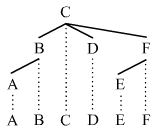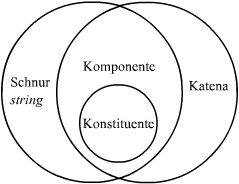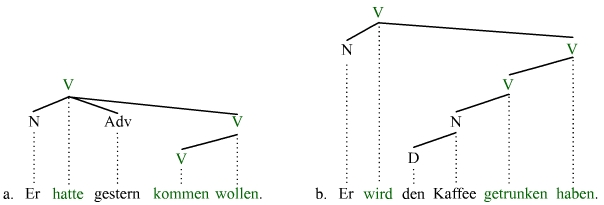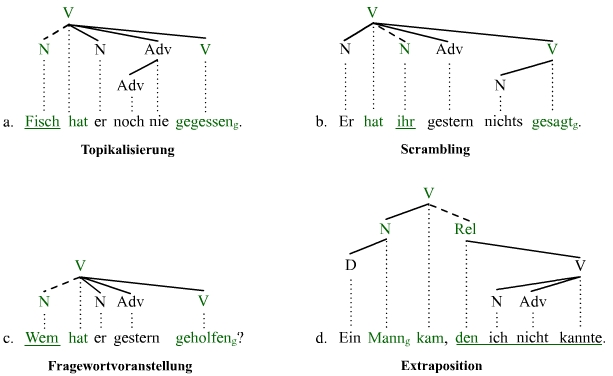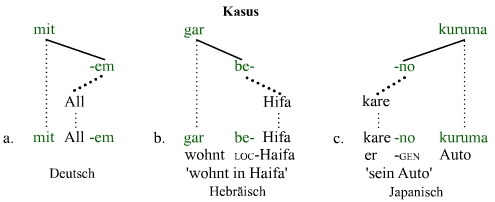Katena (linguistics)
Katena ( Latin catena 'chain'; plural katenae ) is a term in the dependency grammar that has applications in syntax , morphosyntax and morphology .
Concept history
O'Grady suggests the English term "chain" to capture phraseologisms . Central is his observation that many phraseologisms cannot be described as constituents . Osborne realizes that the chain term O'Gradys can be easily won in a dependency grammar . Osborne et al. rename the term to “Katena” in order to avoid misunderstandings with the derivation of “chain”. They argue that the katena is the central concept used to describe phraseologisms and ellipses . Predicate-argument structures and constructions are also katenae. The Katena also use other suggestions to describe morphosyntactic and morphological structures.
definition
In general, “katena” for a dependency tree structure is defined as “any node or any combination of nodes that are in continuous dominance among each other”. According to this definition, a katena corresponds to an entire tree or a sub-tree. A concrete example illustrates this:
The tree above contains the following katenae:
- A, B, C, D, E, F (according to the first part of the definition)
- AB, BC, CD, CF, EF (combinations with two nodes each)
- ABC, BCD, BCF, CDF, CEF (combinations with three nodes each)
- ABCD, ABCF, BCDF, BCEF, CDEF (combinations with four nodes each)
- ABCDF, BCDEF (combinations with five nodes each)
- ABCDEF (the whole tree)
The total number of node combinations is calculated using the formula 2 n -1, where n = number of nodes. Since the tree contains six nodes above, there are 2 6 (= 64) -1 = 63 combinations. However, the number of combinations that count as katenae is only 24, i.e. H. 39 knot combinations are not katenae. These would be, for example, the combinations AC, BDF, ADEF or ABCDE. This can be checked by trying to find a continuous path from one node to other nodes, whereby all nodes on this path must be part of the node combination to be checked. E.g. there is a path from D to F that goes through C but not through E. Therefore CDF is a Katena, but CDE or DEF are not.
Katenae and other units
Is contrasted with the Katena the cord (Engl. String ). A string is defined as "any knot or any combination of knots that are in continuous proximity to one another". In the example above there are 21 strings:
- A, B, C, D, E, F (according to the first part of the definition)
- AB, BC, CD, DE, EF (combinations with two nodes each)
- ABC, BCD, CDE, DEF (combinations with three nodes each)
- ABCD, BCDE, CDEF (combinations with four nodes each)
- ABCDE, BCDEF (combinations with five nodes each)
- ABCDEF (the entire expression)
When a knot combination is a katena and a line at the same time, then it is called a component . In the example above there are 16 components:
- A, B, C, D, E, F (according to the first parts of the underlying definitions)
- AB, BC, CD, EF (combinations with two nodes)
- ABC, BCD (combinations with three nodes)
- ABCD, CDEF (combinations with four nodes)
- BCDEF (combination with five nodes)
- ABCDEF (the entire expression)
The number of components is less than that of the cords or the katenae, since a component must meet both the definition of the cord and that of the katena.
If a component includes all of the nodes that the root (topmost node) of the component dominates, then the component is complete . A complete component is called a constituent . The above example contains six constituents:
- A, D, E (combinations with one knot)
- AB, EF (combinations with two nodes)
- ABCDEF (the entire expression)
The number of possible constituents is small, measured against the number of possible strings, katenae and components, because a knot combination, in order to be considered a constituent, must meet the definitions of the string, the katena and the completeness. From a technical point of view, the constituent is therefore a sub-term to component , which in turn is a sub-term to cord and katena . The diagram below shows these relationships.
The ratio of katenae to constituents is particularly relevant for linguistic analyzes. The property that there are usually more katenae than constituents in an expression is called inclusivity . The katena is more inclusive than the constituents because more combinations of nodes in an expression count as katenae than as constituents.
Syntactic Katenae
A syntactic katena results when the term node in the original definition is replaced by word : A syntactic katena is "any word or any combination of words that are in continuous dominance among one another". Syntactic katenae are real units that play an important role in the analysis of the following phenomena: phraseologism , ellipses , predicate-argument structures , dislocations, and construction grammatical constructions .
Phraseologisms
This is a relatively solid structure, but it is often not a constituent.
The green words are part of the respective phraseologism. The word marked X is free; H. not part of phraseologism. In (a) X is the direct object of the verb, in (b) that of the preposition with . Both phraseologisms cannot be constituents if you want to exclude the free word from the phraseologisms. Phraseologisms and idioms are therefore primarily syntactic katenae, but not necessarily always constituents.
Ellipses
An ellipse occurs when words are missing in the sentence that should actually appear there. About a dozen forms of such repayment mechanisms are known. The following examples are about gapping and sluicing :
The green words are the equivalent of the deleted words (in gray). The green words form katenae, but not constituents, which is why the deleted words must also form katenae. Ellipses have to be katenae, but not necessarily constituents.
Predicate argument structures
Predicates are central parts of a sentence. They are contrasted with arguments or additions and information . Predicates are often verbs, in many languages also in an expanded form, so-called periphrases . The occurrence of arguments / additions and statements often makes it impossible to record the predicate as an independent constituent that excludes arguments and statements.
The green words represent the predicate. In (a) the adverb yesterday interrupts (an indication), and in (b) the object the coffee interrupts its respective predicate in a way that makes it impossible to understand the predicates themselves as constituents. Predicates are always Katenae, unless there is a dislocation.
Dislocations
A dislocation is a sentence position in which at least one word does not appear where one would normally expect it. The motivation for this can be the marking of the displaced word, as with topicalization , scrambling or prefixing the question word , or the length (severity) of a clause can be responsible for the change, as with extra position or heavy NP shift . An approach based on the concept of Katena distinguishes between the following terms:
- Increased Katena : the dislocated word or words
- Rain of the risen katena : the word that determines the shape of the risen katena
- Head of the soaring katena : the word on which the soaring katena depends
- Ascent : a constellation in which a katena (one or more words) does not depend on its rain, but on another word
- Ascent principle : the head of the ascended katena must dominate the rain of the ascended katena
- Ascent katena : the smallest katena that contains the root, head and rain of the ascended katena
The examples (a – d) show different types of dislocation in German. The increased Katena is underlined. The relationship between the risen katena and her head is marked with a dashed line. The rain of the risen Katena receives the subscription g (for English "governor" = rain). The rise catena, d. H. the root, the head and the rain of the ascended katena are green. The slope catenae in (a – d) are not constituents.
Constructions
A construction is any form expression that has a specific meaning. Construction grammars recognize all of the examples shown above; H. Phraseologisms, ellipses, predicate structures and dislocations, and many more than constructions . However, constructions are not restricted to syntax, but also exist in morphology. It has been hypothesized that all constructions are katenae.
Morphological katenae
A morphological katena results when the term knot in the original definition is replaced by morph : A morphological katena is "any morph or any combination of morphs that are in continuous dominance". Under Morph one nichtreduzierbares, significant bearing segment is understood. A distinction is made between intra-word and inter-word katenae.
Intra-word katenae
An intra-word katena is a katena whose nodes are morphs of the same word. This is the case with flexion and derivation :
The decisive factor for this type of morphological katenae is the distribution criterion. The word mach-t has a distribution like the verb sag-t , but not like the verb mach-st . The same applies to the English equivalent do-es and the Japanese equivalent yar-u . The word Les-er has a distribution like the noun Hör-er , but not like the verb les-e . The same applies to the English and Japanese equivalents.
Inter-word katenae
An inter-word katena is a katena whose nodes are not morphs of the same word.
The green nodes in the examples above are inter-word katenae. In order for the word All-em to be dependent on the preposition with , it is necessary that the dative-flexive -em occurs exactly and not another. The same applies to the Hebrew and Japanese examples. Should be-HIFA of not depend so must the locative prefix loading , and not a allatives Prefix occur. And if kare-no is to depend on kuruma , the genitive -no must appear, not another case morph. Because the internal structure of the dependent words form an intra-word katena, the affixes can be viewed as the root. These then form inter-word katenae with the superordinate morphs. This ratio is also known as Directorate called.
Clitization can also be easily described using inter-word katenae:
The green nodes are klitika. In (a) the article is said to m has been reduced and klitisiert to the preposition. This means that the clitic is phonologically part of a word which is superordinate to the word to which the article is subordinate. (b) shows the converse case. The case clitic -tan is superordinate to the noun etxe , but phonologically part of the adjective txiki, which is subordinate to the noun . (c) shows a third case with the English possessive: Here the clitic has a superordinate and a subordinate word. The parent is hat , the child is queen . The clitonic thus establishes the semantic relation between these two words. Phonologically it is part of England , a subordinate word of queen .
notes
- ^ O'Grady (1998)
- ^ Osborne (2005)
- ↑ Osborne et al. (2013)
- ↑ Osborne & Groß (in press)
- ↑ Osborne & Groß (2012)
- ↑ large (2011a, b)
- ↑ Osborne et.al (2013)
- ^ Osborne (2005)
- ↑ Ross (1970)
- ↑ Merchant (2001)
- ↑ Osborne et.al (2013)
- ↑ Osborne & Groß (in press)
- ↑ Groß & Osborne (2009), Osborne (2011)
- ↑ Osborne & Groß (2012)
- ↑ large (2011a)
- ↑ large (2011a)
- ↑ large (2011a)
- ↑ large (2011b)
literature
- Great, Thomas. 2011a. Catenae in Morphology. Depling 2011 Proceedings . 47-57.
- Great, Thomas. 2011b. Clitics in Dependency Morphology. Depling 2011 Proceedings . 58-68.
- Groß, Thomas and Timothy Osborne 2009. Toward a practical DG theory of discontinuities. Sky Journal of Linguistics 22. 43-90.
- Merchant, Jason. 2001. The syntax of silence: Sluicing, islands, and the theory of ellipsis . Oxford: Oxford University Press.
- O'Grady, William. 1998. The syntax of idioms. Natural Language and Linguistic Theory 16, 79-312.
- Osborne, Timothy. 2005. Beyond the constituent: A DG analysis of chains. Folia Linguistica 39, 3-4. 251-297.
- Osborne, Timothy. 2011. Type 2 Rising: A Contribution to a DG Account of Discontinuities. Depling 2011 Proceedings 38-46.
- Osborne, Timothy and Thomas Gross. 2012. Constructions are catenae: Construction Grammar meets dependency grammar. Cognitive Linguistics 23, 1: 163-214.
- Osborne, Timothy and Thomas Gross. In print. Antecedent containment: A dependency grammar solution in terms of catenae. Studia Linguistica .
- Osborne, Timothy, Michael Putnam, and Thomas Groß. 2013. Catenae: Introducing a novel unit of syntactic analysis. Syntax 16, in press.
- John R. Ross: Gapping and the order of constituents. In: Manfred Bierwisch, Karl Erich Heidolph (eds.): Progress in linguistics. Mouton, Den Haag et al. 1970, pp. 249-259 ( Ianua linguarum 43)
